sensor TOYOTA YARIS CROSS 2021 Repair Manual
[x] Cancel search | Manufacturer: TOYOTA, Model Year: 2021, Model line: YARIS CROSS, Model: TOYOTA YARIS CROSS 2021Pages: 650, PDF Size: 132.86 MB
Page 297 of 650
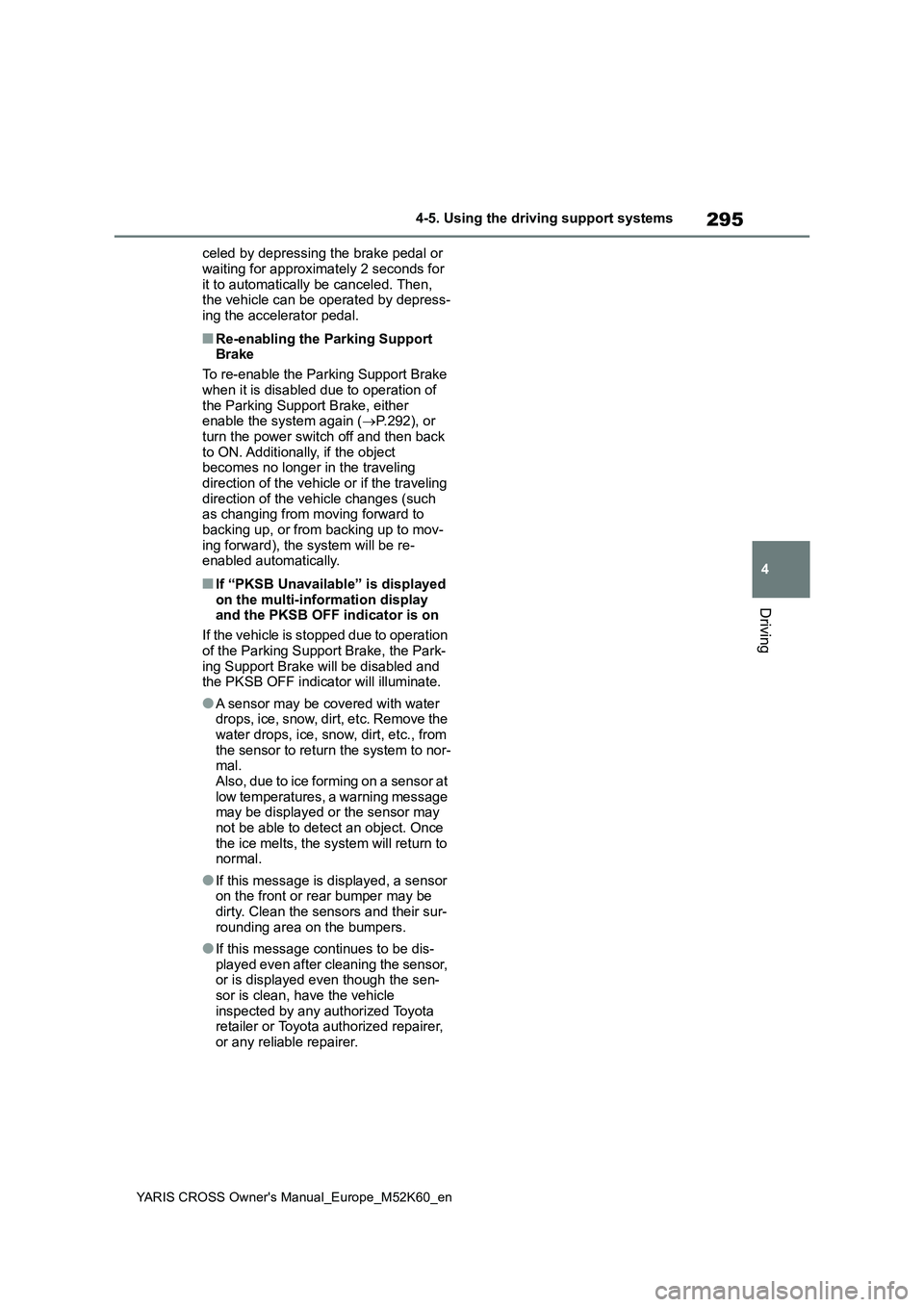
295
4
YARIS CROSS Owner's Manual_Europe_M52K60_en
4-5. Using the driving support systems
Driving
celed by depressing the brake pedal or
waiting for approximately 2 seconds for it to automatically be canceled. Then, the vehicle can be operated by depress-
ing the accelerator pedal.
■Re-enabling the Parking Support Brake
To re-enable the Parking Support Brake
when it is disabled due to operation of the Parking Support Brake, either enable the system again ( P.292), or
turn the power switch off and then back to ON. Additionally, if the object becomes no longer in the traveling
direction of the vehicle or if the traveling direction of the vehicle changes (such as changing from moving forward to
backing up, or from backing up to mov- ing forward), the system will be re-enabled automatically.
■If “PKSB Unavailable” is displayed
on the multi-information display and the PKSB OFF indicator is on
If the vehicle is stopped due to operation
of the Parking Support Brake, the Park- ing Support Brake will be disabled and the PKSB OFF indicator will illuminate.
●A sensor may be covered with water drops, ice, snow, dirt, etc. Remove the
water drops, ice, snow, dirt, etc., from the sensor to return the system to nor-mal.
Also, due to ice forming on a sensor at low temperatures, a warning message may be displayed or the sensor may
not be able to detect an object. Once the ice melts, the system will return to normal.
●If this message is displayed, a sensor on the front or rear bumper may be
dirty. Clean the sensors and their sur- rounding area on the bumpers.
●If this message continues to be dis-played even after cleaning the sensor, or is displayed even though the sen-
sor is clean, have the vehicle inspected by any authorized Toyota retailer or Toyota authorized repairer,
or any reliable repairer.
Page 298 of 650
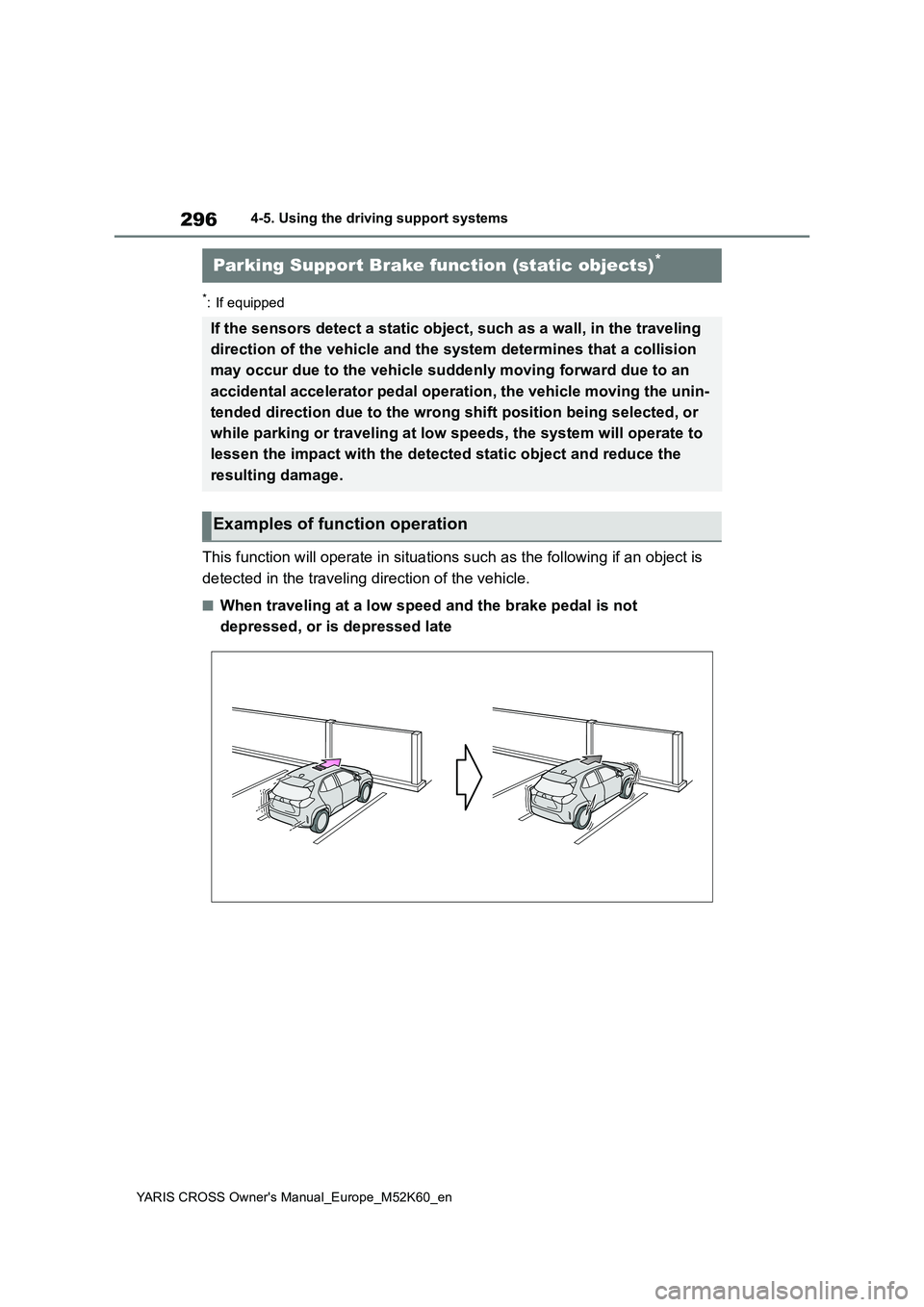
296
YARIS CROSS Owner's Manual_Europe_M52K60_en
4-5. Using the driving support systems
*: If equipped
This function will operate in situations such as the following if an object is
detected in the traveling direction of the vehicle.
■When traveling at a low speed and the brake pedal is not
depressed, or is depressed late
Parking Support Brake function (static objects)*
If the sensors detect a static object, such as a wall, in the traveling
direction of the vehicle and the system determines that a colli sion
may occur due to the vehicle suddenly moving forward due to an
accidental accelerator pedal operation, the vehicle moving the unin-
tended direction due to the wrong shift position being selected, or
while parking or traveling at low speeds, the system will opera te to
lessen the impact with the detected static object and reduce th e
resulting damage.
Examples of function operation
Page 299 of 650
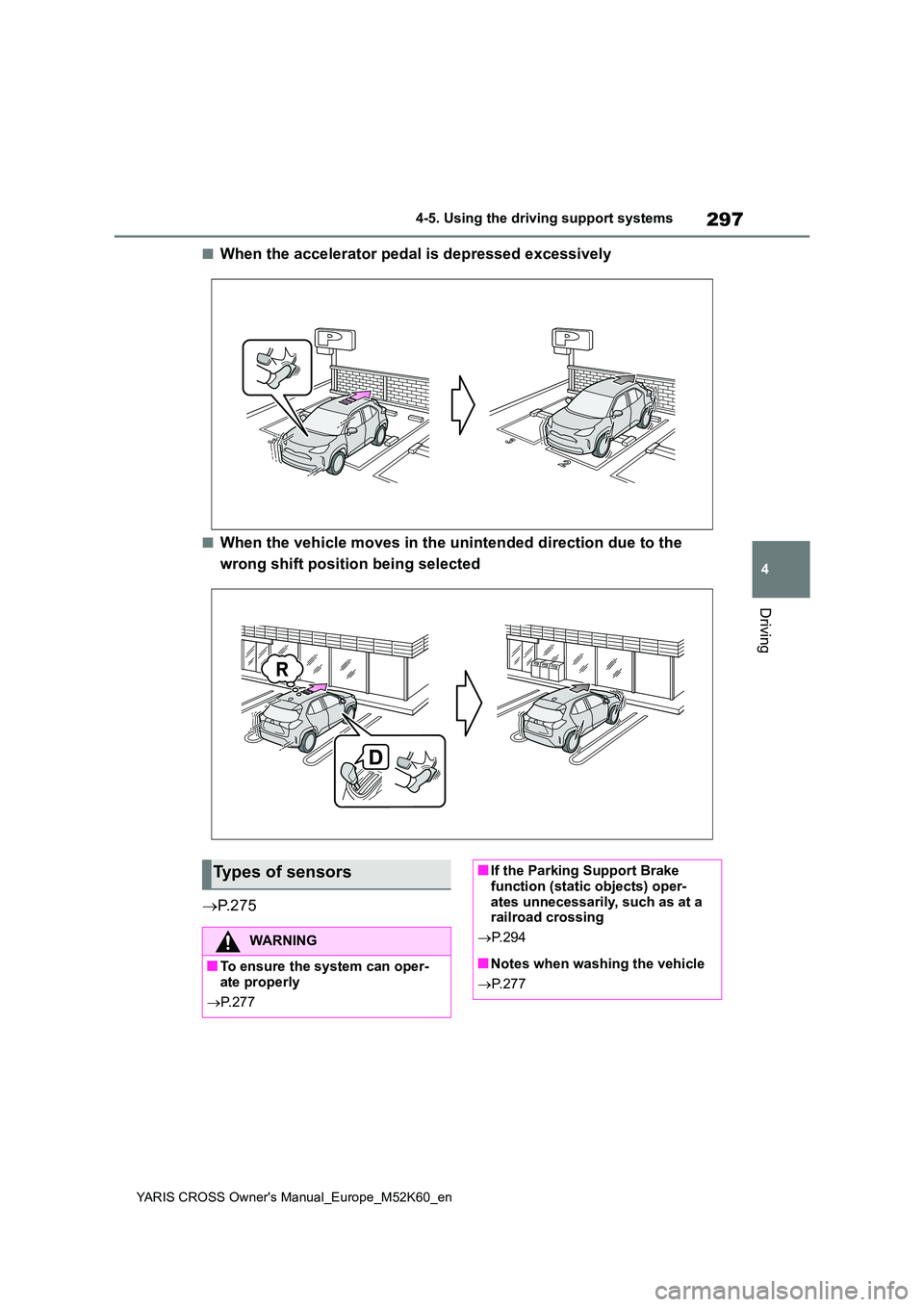
297
4
YARIS CROSS Owner's Manual_Europe_M52K60_en
4-5. Using the driving support systems
Driving
■When the accelerator pedal is depressed excessively
■When the vehicle moves in the unintended direction due to the
wrong shift position being selected
P. 2 7 5
Types of sensors
WARNING
■To ensure the system can oper- ate properly
P. 2 7 7
■If the Parking Support Brake function (static objects) oper-
ates unnecessarily, such as at a railroad crossing
P. 2 9 4
■Notes when washing the vehicle
P. 2 7 7
Page 300 of 650
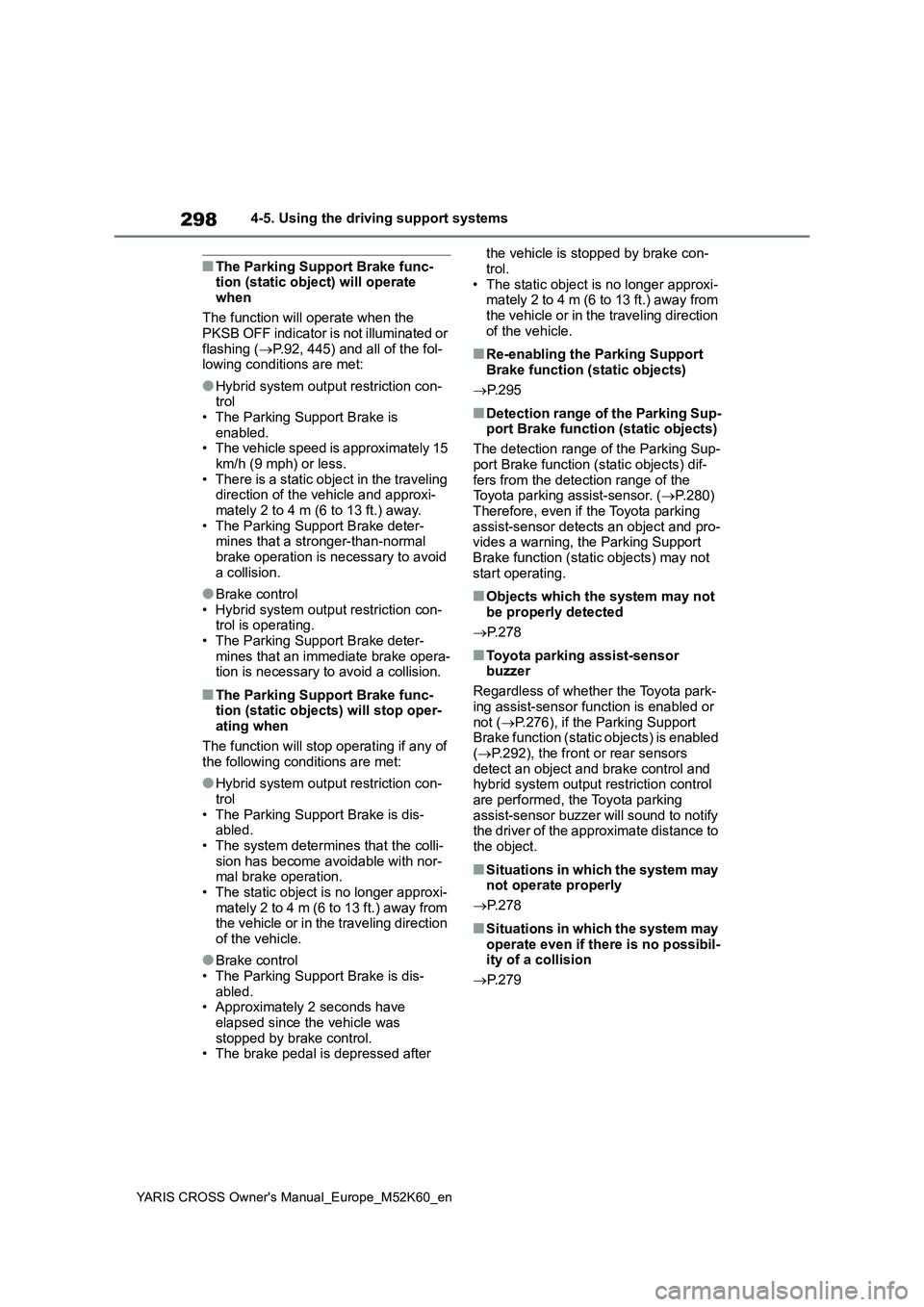
298
YARIS CROSS Owner's Manual_Europe_M52K60_en
4-5. Using the driving support systems
■The Parking Support Brake func- tion (static object) will operate
when
The function will operate when the PKSB OFF indicator is not illuminated or
flashing ( P.92, 445) and all of the fol- lowing conditions are met:
●Hybrid system output restriction con-trol• The Parking Support Brake is
enabled. • The vehicle speed is approximately 15 km/h (9 mph) or less.
• There is a static object in the traveling direction of the vehicle and approxi-mately 2 to 4 m (6 to 13 ft.) away.
• The Parking Support Brake deter- mines that a stronger-than-normal brake operation is necessary to avoid
a collision.
●Brake control
• Hybrid system output restriction con- trol is operating.• The Parking Support Brake deter-
mines that an immediate brake opera- tion is necessary to avoid a collision.
■The Parking Support Brake func-tion (static objects) will stop oper-
ating when
The function will stop operating if any of the following conditions are met:
●Hybrid system output restriction con-
trol • The Parking Support Brake is dis-abled.
• The system determines that the colli- sion has become avoidable with nor-mal brake operation.
• The static object is no longer approxi- mately 2 to 4 m (6 to 13 ft.) away from the vehicle or in the traveling direction
of the vehicle.
●Brake control
• The Parking Support Brake is dis- abled.• Approximately 2 seconds have
elapsed since the vehicle was stopped by brake control.• The brake pedal is depressed after
the vehicle is stopped by brake con-
trol. • The static object is no longer approxi-mately 2 to 4 m (6 to 13 ft.) away from
the vehicle or in the traveling direction of the vehicle.
■Re-enabling the Parking Support Brake function (static objects)
P. 2 9 5
■Detection range of the Parking Sup- port Brake function (static objects)
The detection range of the Parking Sup-
port Brake function (static objects) dif- fers from the detection range of the Toyota parking assist-sensor. ( P.280)
Therefore, even if the Toyota parking assist-sensor detects an object and pro-vides a warning, the Parking Support
Brake function (static objects) may not start operating.
■Objects which the system may not be properly detected
P. 2 7 8
■Toyota parking assist-sensor buzzer
Regardless of whether the Toyota park-
ing assist-sensor function is enabled or not ( P.276), if the Parking Support Brake function (static objects) is enabled
( P.292), the front or rear sensors detect an object and brake control and hybrid system output restriction control
are performed, the Toyota parking assist-sensor buzzer will sound to notify the driver of the approximate distance to
the object.
■Situations in which the system may not operate properly
P. 2 7 8
■Situations in which the system may
operate even if there is no possibil- ity of a collision
P. 2 7 9
Page 301 of 650
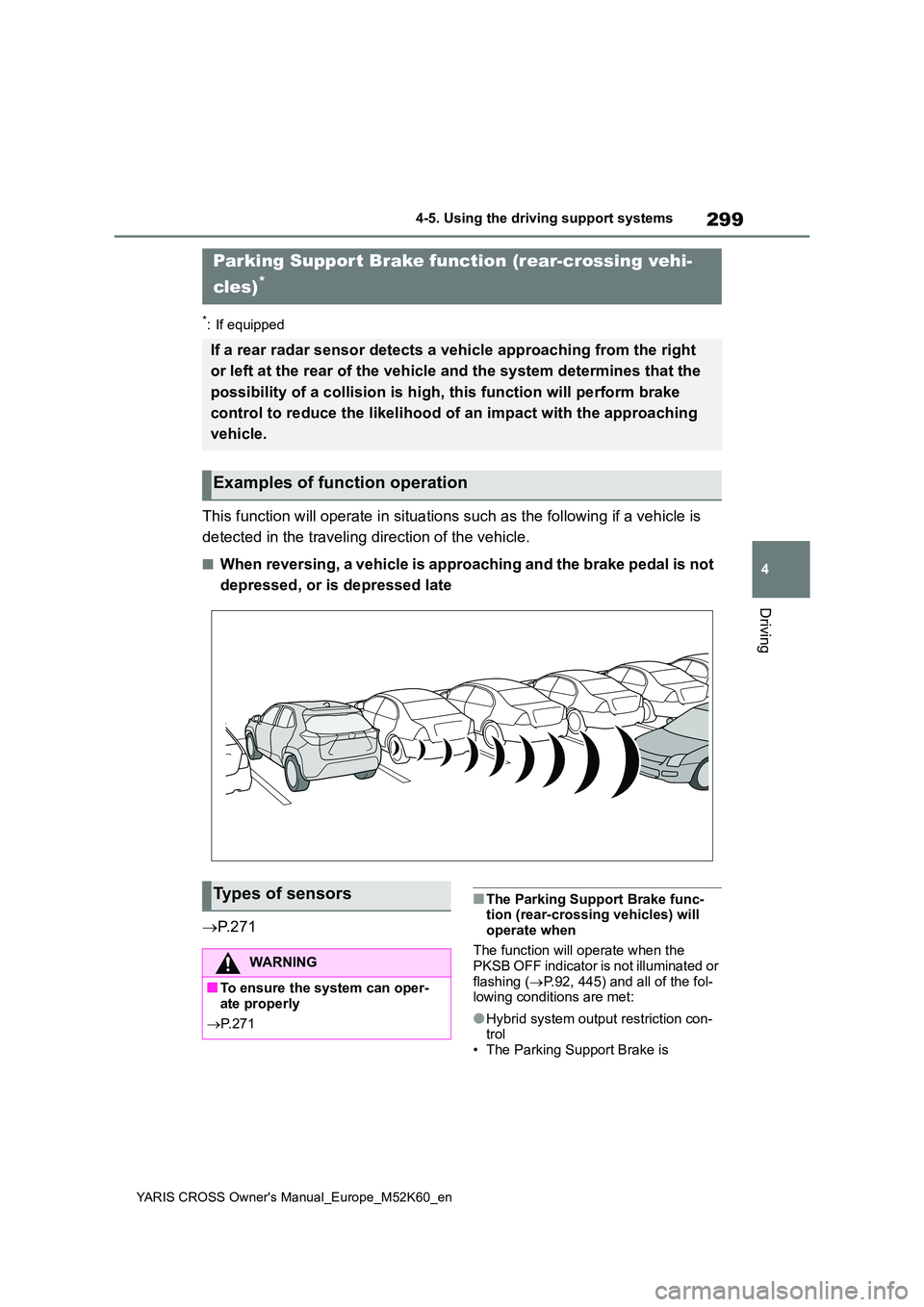
299
4
YARIS CROSS Owner's Manual_Europe_M52K60_en
4-5. Using the driving support systems
Driving
*: If equipped
This function will operate in situations such as the following if a vehicle is
detected in the traveling direction of the vehicle.
■When reversing, a vehicle is approaching and the brake pedal is not
depressed, or is depressed late
P. 2 7 1
■The Parking Support Brake func- tion (rear-crossing vehicles) will
operate when
The function will operate when the PKSB OFF indicator is not illuminated or
flashing ( P.92, 445) and all of the fol- lowing conditions are met:
●Hybrid system output restriction con-trol• The Parking Support Brake is
Parking Support Brake function (rear-crossing vehi-
cles)*
If a rear radar sensor detects a vehicle approaching from the r ight
or left at the rear of the vehicle and the system determines th at the
possibility of a collision is h igh, this function will perform brake
control to reduce the likelihood of an impact with the approach ing
vehicle.
Examples of function operation
Types of sensors
WARNING
■To ensure the system can oper- ate properly
P. 2 7 1
Page 315 of 650
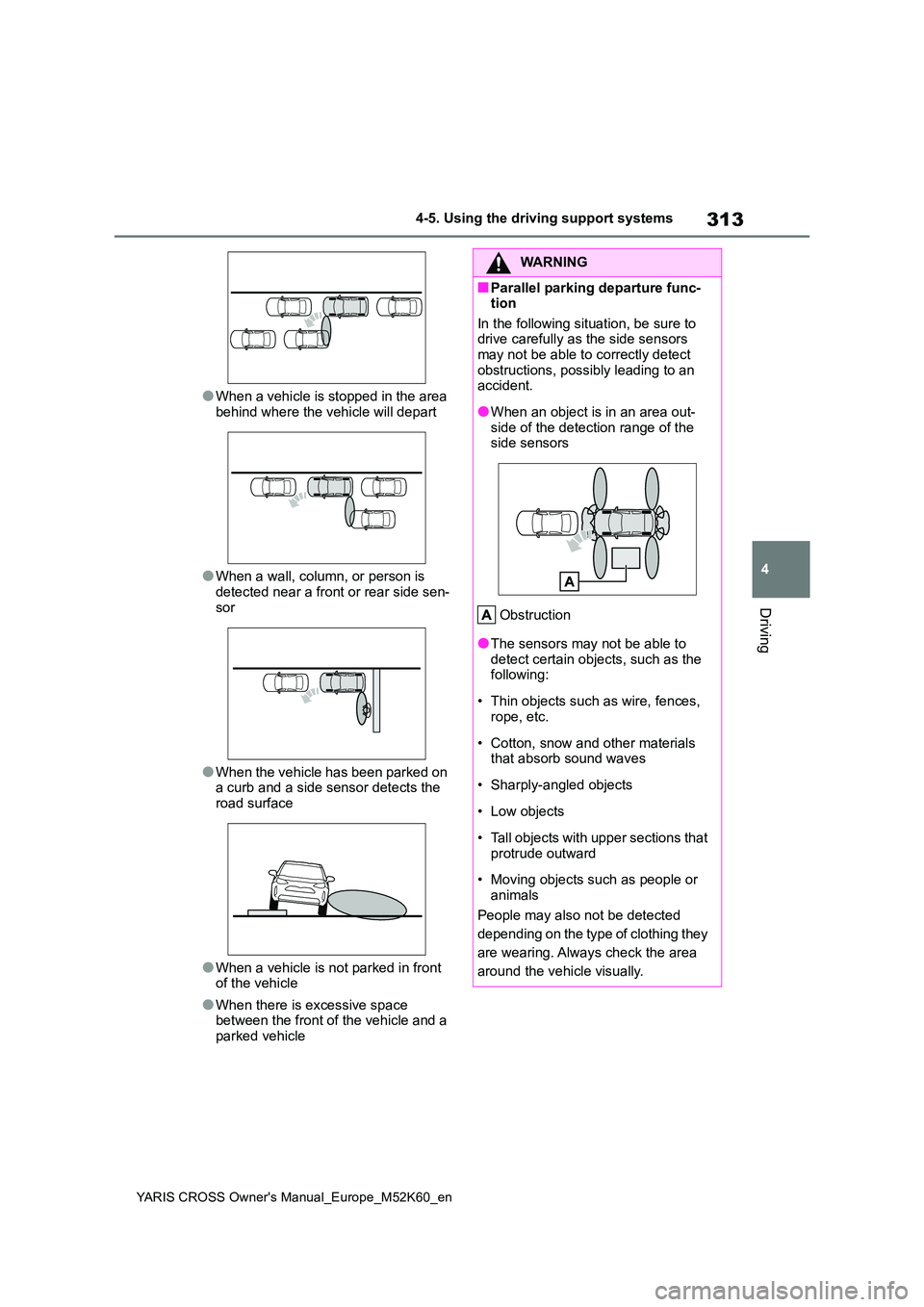
313
4
YARIS CROSS Owner's Manual_Europe_M52K60_en
4-5. Using the driving support systems
Driving
●When a vehicle is stopped in the area
behind where the vehicle will depart
●When a wall, column, or person is
detected near a front or rear side sen- sor
●When the vehicle has been parked on a curb and a side sensor detects the road surface
●When a vehicle is not parked in front of the vehicle
●When there is excessive space between the front of the vehicle and a
parked vehicle
WARNING
■Parallel parking departure func- tion
In the following situation, be sure to drive carefully as the side sensors may not be able to correctly detect
obstructions, possibly leading to an accident.
●When an object is in an area out-side of the detection range of the side sensors
Obstruction
●The sensors may not be able to detect certain objects, such as the following:
• Thin objects such as wire, fences, rope, etc.
• Cotton, snow and other materials that absorb sound waves
• Sharply-angled objects
• Low objects
• Tall objects with upper sections that
protrude outward
• Moving objects such as people or
animals
People may also not be detected
depending on the type of clothing they
are wearing. Always check the area
around the vehicle visually.
Page 329 of 650
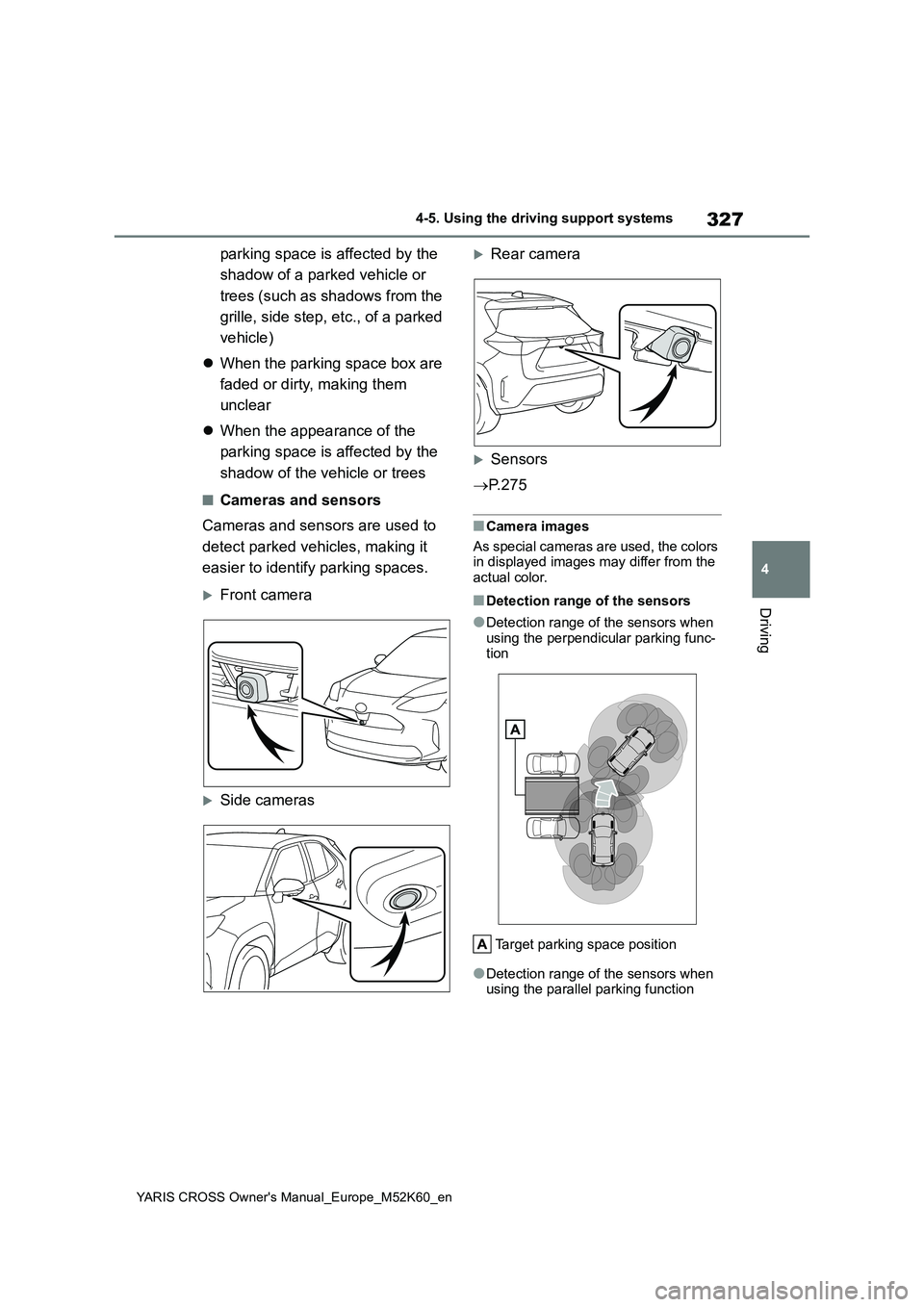
327
4
YARIS CROSS Owner's Manual_Europe_M52K60_en
4-5. Using the driving support systems
Driving
parking space is affected by the
shadow of a parked vehicle or
trees (such as shadows from the
grille, side step, etc., of a parked
vehicle)
When the parking space box are
faded or dirty, making them
unclear
When the appearance of the
parking space is affected by the
shadow of the vehicle or trees
■Cameras and sensors
Cameras and sensors are used to
detect parked vehicles, making it
easier to identify parking spaces.
Front camera
Side cameras
Rear camera
Sensors
P. 2 7 5
■Camera images
As special cameras are used, the colors in displayed images may differ from the
actual color.
■Detection range of the sensors
●Detection range of the sensors when
using the perpendicular parking func- tion
Target parking space position
●Detection range of the sensors when using the parallel parking function
Page 330 of 650
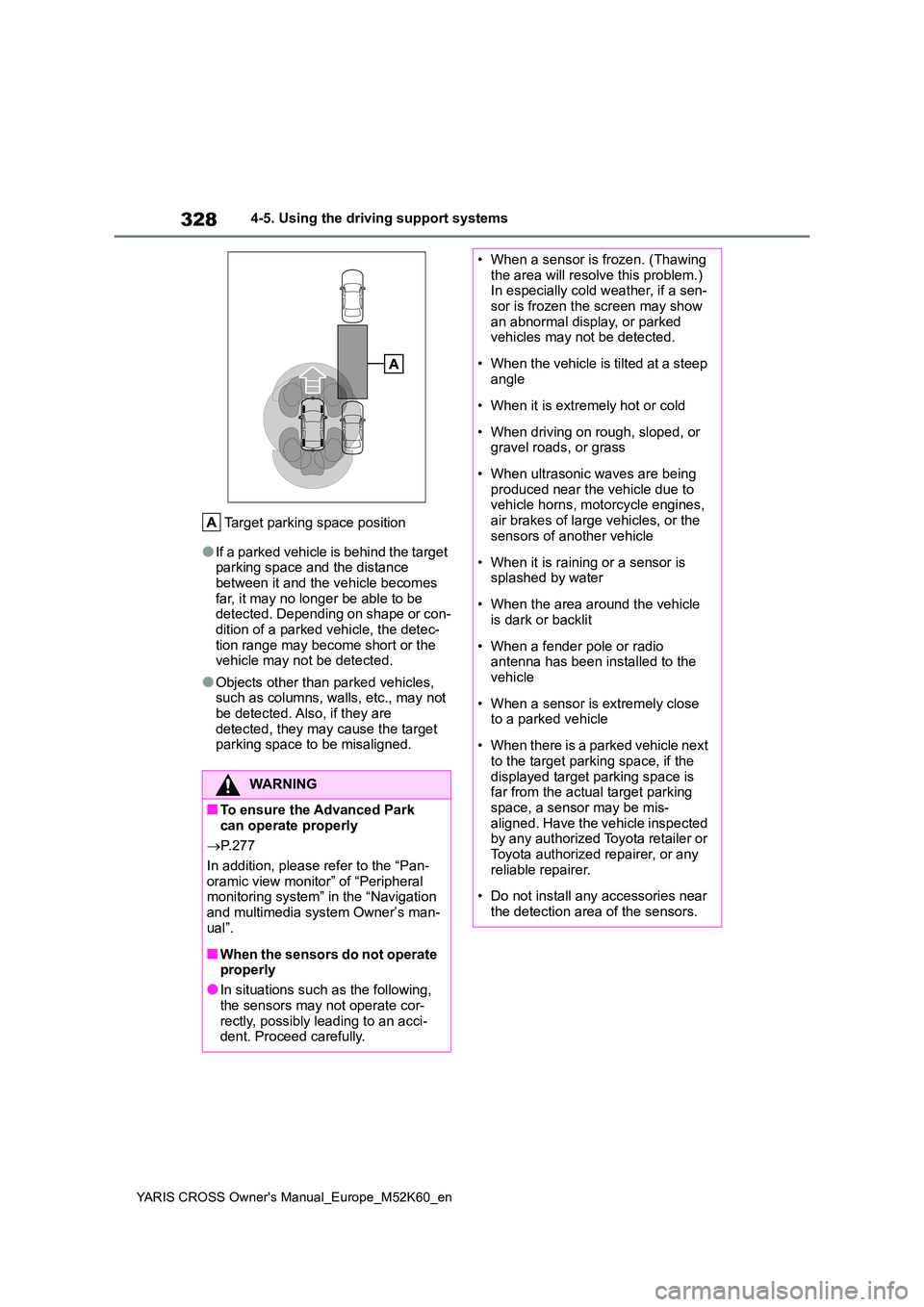
328
YARIS CROSS Owner's Manual_Europe_M52K60_en
4-5. Using the driving support systems
Target parking space position
●If a parked vehicle is behind the target parking space and the distance between it and the vehicle becomes
far, it may no longer be able to be detected. Depending on shape or con-dition of a parked vehicle, the detec-
tion range may become short or the vehicle may not be detected.
●Objects other than parked vehicles, such as columns, walls, etc., may not be detected. Also, if they are
detected, they may cause the target parking space to be misaligned.
WARNING
■To ensure the Advanced Park can operate properly
P. 2 7 7
In addition, please refer to the “Pan- oramic view monitor” of “Peripheral monitoring system” in the “Navigation
and multimedia system Owner’s man- ual”.
■When the sensors do not operate properly
●In situations such as the following,
the sensors may not operate cor- rectly, possibly leading to an acci-dent. Proceed carefully.
• When a sensor is frozen. (Thawing the area will resolve this problem.) In especially cold weather, if a sen-
sor is frozen the screen may show an abnormal display, or parked vehicles may not be detected.
• When the vehicle is tilted at a steep angle
• When it is extremely hot or cold
• When driving on rough, sloped, or gravel roads, or grass
• When ultrasonic waves are being produced near the vehicle due to vehicle horns, motorcycle engines,
air brakes of large vehicles, or the sensors of another vehicle
• When it is raining or a sensor is splashed by water
• When the area around the vehicle is dark or backlit
• When a fender pole or radio antenna has been installed to the vehicle
• When a sensor is extremely close to a parked vehicle
• When there is a parked vehicle next to the target parking space, if the
displayed target parking space is far from the actual target parking space, a sensor may be mis-
aligned. Have the vehicle inspected by any authorized Toyota retailer or Toyota authorized repairer, or any
reliable repairer.
• Do not install any accessories near
the detection area of the sensors.
Page 339 of 650
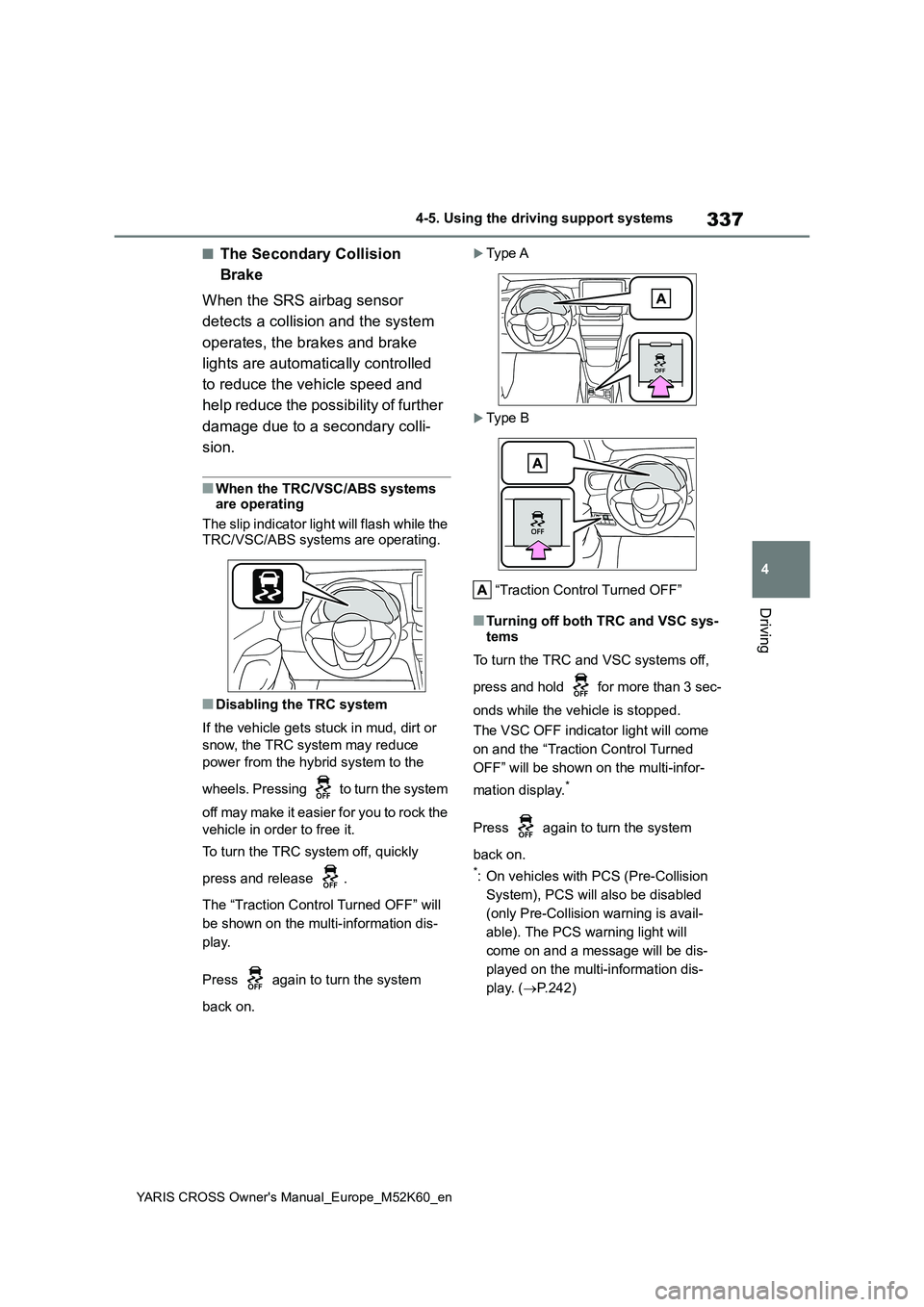
337
4
YARIS CROSS Owner's Manual_Europe_M52K60_en
4-5. Using the driving support systems
Driving
■The Secondary Collision
Brake
When the SRS airbag sensor
detects a collision and the system
operates, the brakes and brake
lights are automatically controlled
to reduce the vehicle speed and
help reduce the possibility of further
damage due to a secondary colli-
sion.
■When the TRC/VSC/ABS systems are operating
The slip indicator light will flash while the
TRC/VSC/ABS systems are operating.
■Disabling the TRC system
If the vehicle gets stuck in mud, dirt or
snow, the TRC system may reduce
power from the hybrid system to the
wheels. Pressing to turn the system
off may make it easier for you to rock the
vehicle in order to free it.
To turn the TRC system off, quickly
press and release .
The “Traction Control Turned OFF” will
be shown on the multi-information dis-
play.
Press again to turn the system
back on.
Ty p e A
Ty p e B
“Traction Control Turned OFF”
■Turning off both TRC and VSC sys- tems
To turn the TRC and VSC systems off,
press and hold for more than 3 sec-
onds while the vehicle is stopped.
The VSC OFF indicator light will come
on and the “Traction Control Turned
OFF” will be shown on the multi-infor-
mation display.*
Press again to turn the system
back on.
*: On vehicles with PCS (Pre-Collision
System), PCS will also be disabled
(only Pre-Collision warning is avail-
able). The PCS warning light will
come on and a message will be dis-
played on the multi-information dis-
play. ( P.242)
Page 341 of 650
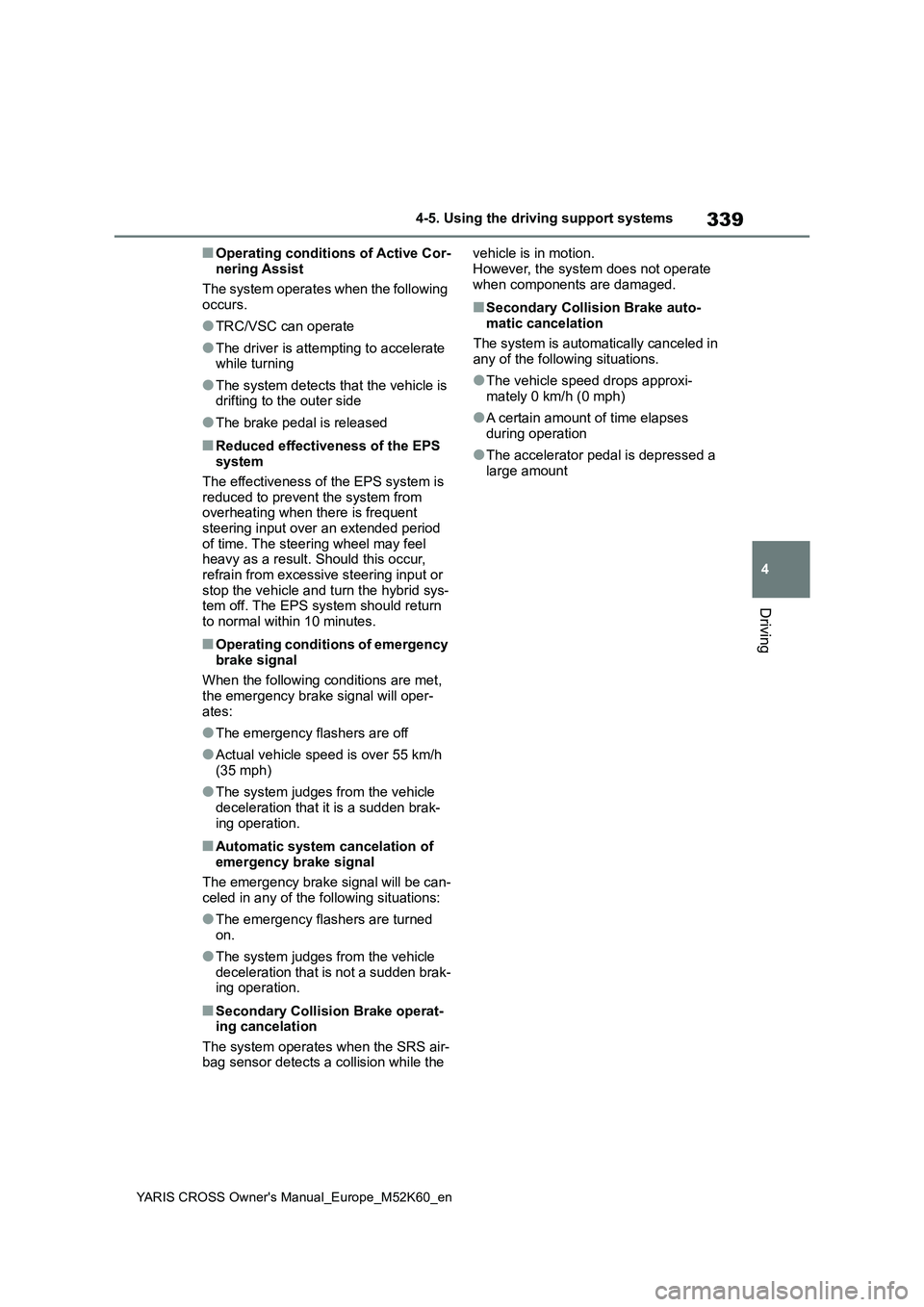
339
4
YARIS CROSS Owner's Manual_Europe_M52K60_en
4-5. Using the driving support systems
Driving
■Operating conditions of Active Cor-
nering Assist
The system operates when the following occurs.
●TRC/VSC can operate
●The driver is attempting to accelerate while turning
●The system detects that the vehicle is drifting to the outer side
●The brake pedal is released
■Reduced effectiveness of the EPS system
The effectiveness of the EPS system is
reduced to prevent the system from overheating when there is frequent steering input over an extended period
of time. The steering wheel may feel heavy as a result. Should this occur, refrain from excessive steering input or
stop the vehicle and turn the hybrid sys- tem off. The EPS system should return to normal within 10 minutes.
■Operating conditions of emergency
brake signal
When the following conditions are met, the emergency brake signal will oper-
ates:
●The emergency flashers are off
●Actual vehicle speed is over 55 km/h (35 mph)
●The system judges from the vehicle deceleration that it is a sudden brak-
ing operation.
■Automatic system cancelation of emergency brake signal
The emergency brake signal will be can-
celed in any of the following situations:
●The emergency flashers are turned
on.
●The system judges from the vehicle
deceleration that is not a sudden brak- ing operation.
■Secondary Collision Brake operat-ing cancelation
The system operates when the SRS air- bag sensor detects a collision while the
vehicle is in motion.
However, the system does not operate when components are damaged.
■Secondary Collision Brake auto-matic cancelation
The system is automatically canceled in any of the following situations.
●The vehicle speed drops approxi-mately 0 km/h (0 mph)
●A certain amount of time elapses during operation
●The accelerator pedal is depressed a large amount